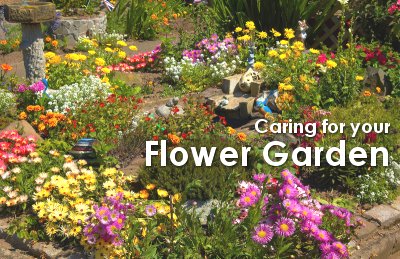Caring for Your Flower Garden
Our readers worldwide have shared with us their favorite flower gardening tips. These easy, yet practical tips will ensure a pretty flower garden that remains colorful throughout the year.

1. Deadheading will Encourage More Blossoms
Deadheading is an essential part of flower garden care and in simple words means – snipping off the flower head after it wilts. This makes the plant produce more flowers. One step of caution though. Throwing the discarded deadheads on the garden will help mildew and other plant disease attack all your plants. So take care not to do that.
2. Water, Sunlight and Soil
As you have no doubt read in every flower gardening guide, your garden needs an adequate supply of water, sunlight, and good, fertile soil. Any lack of these basic necessities will greatly affect the health of plants. Water the flower garden frequently during dry spells. Soaker hoses are a great help. Make sure all your plants receive a fair amount of sunlight. Planting in containers will make it easy for you to move the plants to and from shade as needed.
When planting bulbs, make sure you plant them at the correct depth. When planting shrubs and perennials, make sure that you don’t heap too much soil or mulch around the stem. It causes water to drain off instead of sinking in and as a result, the stem could develop a rot through overheating.
3. Mixing Perennials with Annuals
With some thought put in the planting process or when planning a new garden, your garden will never be out of color. Mix and match perennials with annuals to have a flower garden that always blooms. While perennials are indispensable in beds, borders, and containers, low-care annuals help to fill up the gap when season changes. Consider their bloom-times when planting so that you have something or the other blooming all round the year.
4. Plan for Color
Although this depends on your personal tastes, we received some very good tips from our readers that we would like to share. A color scheme is a good idea for those who love to decorate in and out. Even if you’d rather not go with a particular color combination, it is recommended to buy flowers bulbs and plants of one single color and not a mixed variety. Most mixed colors tend to give a garish look to the garden unless they are specifically bred for a good color combination.
5. Foliage Plays an Important Role
To bring out the beauty of your flower garden, you need to choose appropriate foliage to complement your blooms. Leafy greens like cabbage and lettuce and herbs like rosemary and fennel provide a good backdrop to flowers.
6. Let the Garden Bugs Help You Out
Most garden bugs and insects do more good than harm. Whereas butterflies, beetles and bees pollinate and fertilize plants through unintentional transfer of pollen from one plant to another, sowbugs and dung beetles together with fungi, bacteria and other microorganisms help in the decomposition of dead plant material, thus enriching the soil and making more nutrients available to growing plants. Insects like lacewings and dragonflies are natural predators of harmful insects like aphis.
| Related Articles: |

